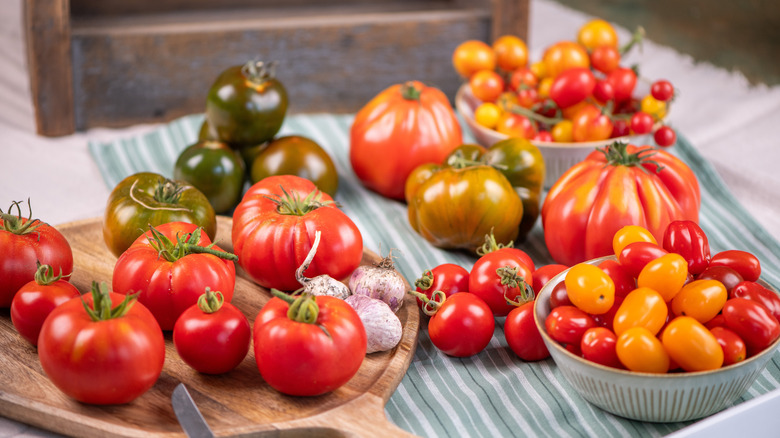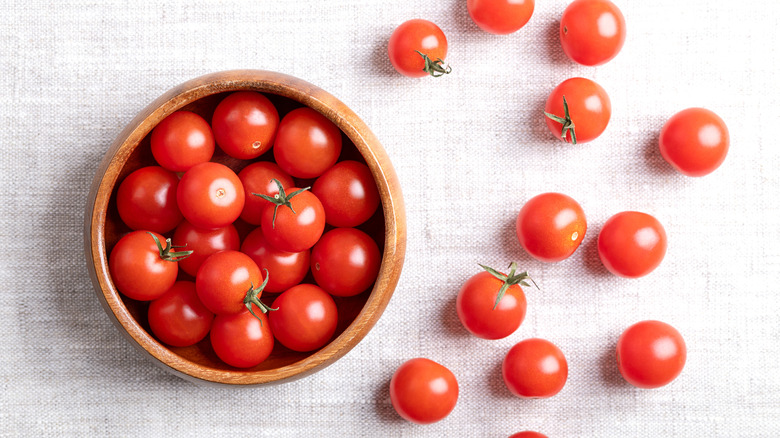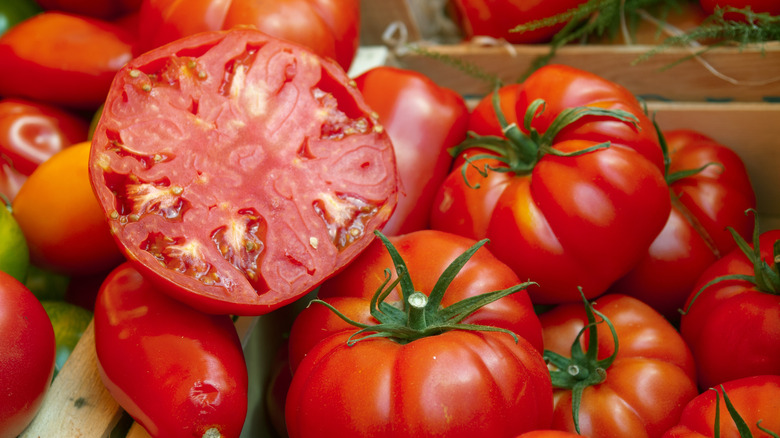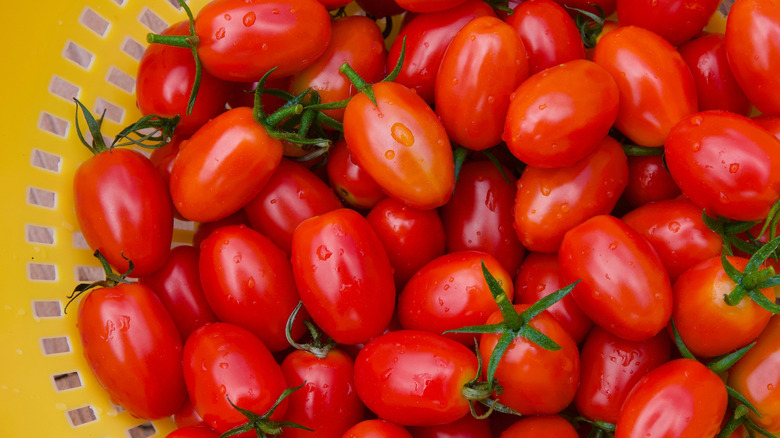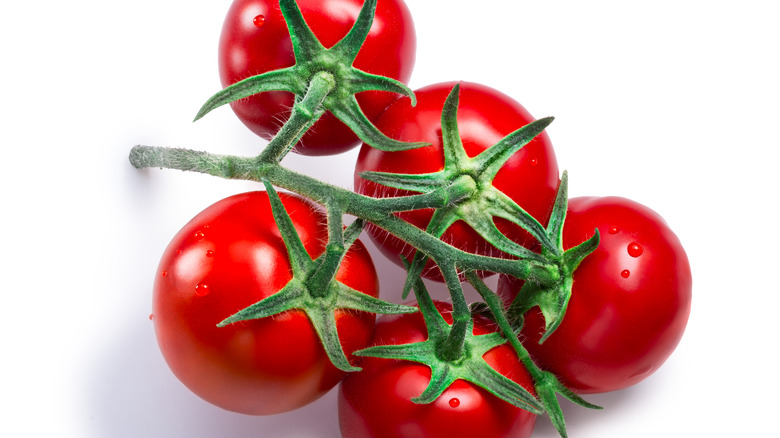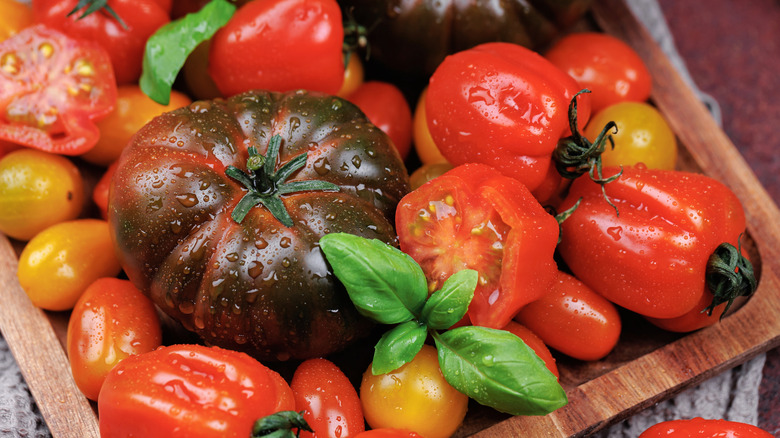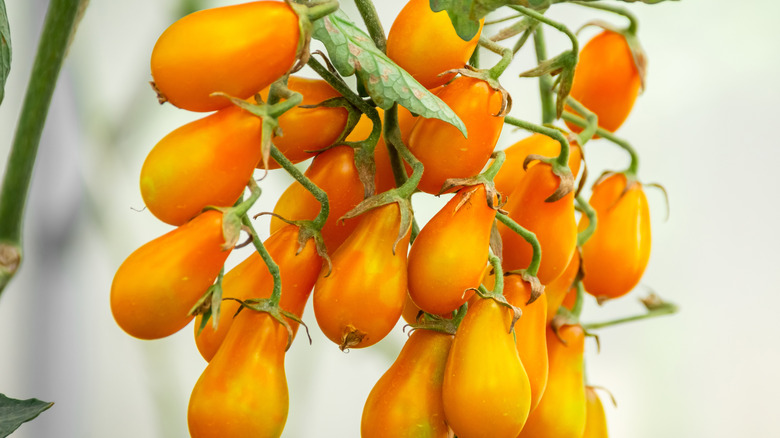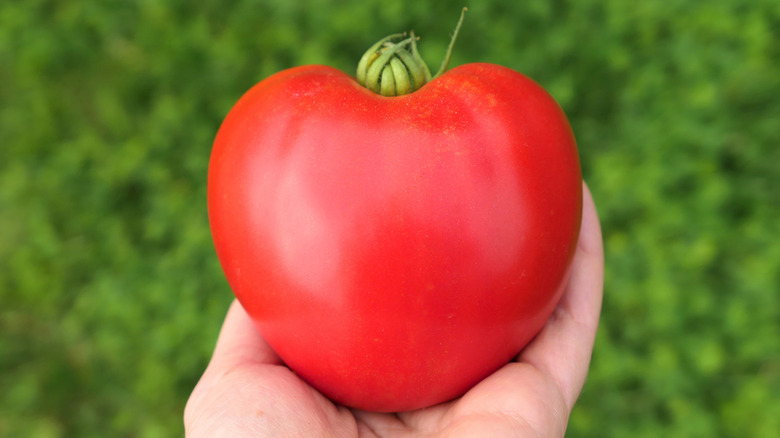The Differences Between 10 Types Of Tomatoes
When you are shopping for tomatoes in the grocery store, you are usually met with a huge variety of shapes, sizes, and colors. In some cases, there is a whole aisle dedicated only to tomatoes, and choosing the right type for your weekly shop can be overwhelming.
Though there are more than 10,000 varieties of tomato available, most of them fall into a handful of broad categories, making it a little easier to work out which ones to choose. From bite-sized cherry tomatoes that are ideal for snacking to substantial beefsteaks that can be stuffed and roasted, each type of tomato has unique qualities that make it perfect for some culinary uses — and less than ideal for others. Whether it is the level of sweetness, the number of seeds, or the firmness of the flesh, understanding the various types can make a difference to the final dish.
Whether you are stuck in a tomato rut or are just looking to add some unusual varieties to your shopping list, we've got you covered. Join us as we take a look at the differences between 10 types of tomatoes.
Cherry
Cherry tomatoes are the star of lunch boxes and picnics everywhere, as their diminutive size and delightful sweet taste make them an ideal juicy snack. Named for their resemblance in size and shape to a cherry, they come in a variety of colors in addition to the usual bright red. These include green, yellow, orange, and a purple that is so dark, it is known as "black cherry."
From a culinary perspective, cherry tomatoes are often eaten raw, and bursting into a whole one without making a mess is a fun challenge of eating them. They are sweeter than many other varieties, meaning it is incredibly easy to polish off a handful of them with little effort. They are an excellent salad option and easy to prepare, as just a quick slice in half will have them ready to plate in seconds. A Caprese salad made with cherry tomatoes is a fun twist on the original, and they also pair brilliantly with feta in a Greek salad.
Don't overlook the benefits of cooking these tiny toms, though, as roasting them brings out their natural sweetness and creates a great side dish to fish or meat, especially if they are roasted on the vine. You can also quickly sauté them in the pan to soften slightly, altering the texture from their usual raw form. Sungold is a popular variety of cherry tomato, and the bright orange color makes it a good compromise between red and yellow — bursting with juicy sweetness and plenty of vitamin C.
Plum
If you're looking to make a sauce out of your tomatoes, then plums are definitely the variety to try. They have a soft interior and fewer seeds than many other types, making them ideal for any dish where you want the juice to escape and create a delicious sauce. San Marzano is a famous variety of prized plum tomato, grown in Naples and considered among the best worldwide, and a high-quality can of tomatoes will often contain this type.
Fresh plum tomatoes are often the Roma variety, which you can use to create a rich, flavorsome sauce from scratch by cooking them until the skins split. Afterward, you can let them simmer until they form a thick, satisfying paste, infused with plenty of fresh or dried Italian herbs — basil and oregano work particularly well to create that Mediterranean flavor. Alternatively, you can roast them and then blend, sieving afterward if you want a smooth sauce to add to pizza. Whatever saucy dish you're in the mood for, starting with plum tomatoes will give the best chance of a sweet sauce with a hint of acidity, and a deep, tomatoey flavor.
Beefsteak
When it comes to hefty tomatoes, beefsteak are the ultimate variety — large, juicy, and with a meaty texture that is incredibly satisfying. They are the perfect tomato to use on top of a burger, but there are plenty of other delicious uses for them.
If you find that the sliced tomatoes in your sandwich have a tendency to slip over each other, the beefsteak can come to your rescue. One slice will cover the majority of the sandwich, meaning you don't need to create a slippery tomato jigsaw just to get a piece in every mouthful. They are also the ideal tomato for stuffing, whether with rice, beef, or vegetables, and can even be hollowed out and filled with an egg before baking as an extra-tasty breakfast dish.
If you want to get the most out of a beefsteak tomato, though, eating it fresh is the best plan. For a fancy presentation of Caprese salad, cut fresh mozzarella and a beefsteak tomato into similar-sized rings and alternate them with a large basil leaf between each layer — this will help you create a vibrant red, green, and white tower that is a delicious representation of the Italian flag. Drizzle with high-quality extra virgin olive oil and balsamic vinegar, and you'll have a showstopping starter, thanks to the hearty juiciness of the beefsteak tomatoes.
Grape
Another tomato named after a fruit is the grape tomato, so-called due to its oval shape and petite size. While many people may assume they are simply cherry tomatoes with a slightly elongated shape, they are actually a different type with differences in the flavor and texture.
As well as the visible difference in shape, grape tomatoes have a firmer texture than their cherry cousins. They also have less juice, meaning you won't get the same explosion in your mouth when you bite into them, and they are not quite as sweet. In spite of the subtle differences, they can still be an excellent alternative to cherry tomatoes if you fancy a change.
Their thicker skin makes them an ideal option for roasting whole in the oven, and they are less likely to split, resulting in a more elegant presentation. They come in various colors, too, including green, yellow, and orange, meaning you can mix and match for a rainbow of colors in your dishes. They are just as moreish as cherry tomatoes as a healthy snack or salad side dish. This variety can make it into your tomato rotation as an interesting alternative to your usual lunch box favorites.
Globe
If you ask someone to go to the grocery store and pick up tomatoes without specifying a type, chances are they will come back with globe tomatoes. As the name suggests, these are round tomatoes, and they often go by the name of slicing tomatoes, as they are regularly used on sandwiches and in salad.
Globe tomatoes are incredibly versatile, and their mild flavor means they can be paired with most other foods without stealing the show. They don't have as intense a flavor as a cherry or beefsteak tomato, but that doesn't put shoppers off, as they are a very popular option that fill the shelves of the produce section in the grocery store. Their mild flavor means you can add a slice or two to a grilled cheese sandwich or dice them up for a flavorsome salsa or guacamole.
Their firm flesh and abundance of seeds make them a recognizable tomato for most people. They are a great option to have in the fridge for whenever you feel the need to whip up a quick salad or sandwich. They may not be the flashiest tomatoes on our list, but they are dependable, which is why so many people turn to them as the first choice.
Heirloom
Understanding heirloom tomatoes can be tricky, as they are often labeled with other varieties, such as "cherry" or "beefsteak." This is because heirloom tomatoes are not categorized by their shape, but by their heritage. Heirloom tomatoes are ones whose seeds have been passed down throughout the generations without being crossed with other varieties — essentially, they are the pure-breeds of the tomato kingdom.
The 1950s was the decade that hybrid tomato varieties began to take off, so many heirlooms pre-date this. They are prized for their exceptionally thin skins and superb flavor, and they are at their best when prepared in a simple fashion. Buy them at the farmers' market, take them home, and eat them immediately while they are at their peak. Heirloom beefsteaks are perfect on bruschetta, while heirloom cherry tomatoes are a fabulous addition to fresh salads. They may not look as uniform and pretty as some of the hybrid tomatoes in the supermarket, but that is the whole point. Embrace their natural shape and color variations, and enjoy tomatoes as they are supposed to be eaten.
Pear
If you've had enough of your tomatoes looking like cherries, plums, or grapes, the next variety on our list will make a nice change. Pear tomatoes are, funnily enough, pear shaped, and tend to be yellow in color (though they can also be bright red or orange). Their unusual shape makes them an eye-catching addition to salads, and they can stand out alongside other varieties on a platter or charcuterie board.
Pear tomatoes are not particularly acidic, but have a tasty tang to cut through the sweetness. They have a subtle flavor with less intensity than some of the others on this list, and pairing them with other varieties of tomato is often a good move both in terms of presentation and flavor. A brilliant option would be a fresh tomato salsa, combining yellow pear tomatoes with a bright red grape or cherry variety. Though they are delicious raw, you can also lightly roast them to increase the sweetness — serve with steamed fish or a piece of grilled chicken.
Cocktail
Cocktail tomatoes are less well known than their cherry or plum cousins, but they deserve just as much recognition. Sitting roughly between the two in terms of size, they have a round shape that makes them very attractive on the plate. When served on the vine, they make an elegant accompaniment to meat or fish.
They are a versatile variety, just as happy adorning a piece of bruschetta as they are starring in a fresh salad. They can be roasted, sauteed, grilled, or simply enjoyed fresh, their juices bursting out as you bite into them. A small bunch of cocktail tomatoes on the vine can make a stunning addition to a charcuterie board, and the intense tomato flavor will pair brilliantly with virtually any cheese and cured meats. If you want to do something a little different, cocktail tomatoes are just big enough to stuff. Cream cheese is always a great option — make sure to add some fresh basil — or tuna mayo and capers if you want to go down the fish route. Instead of the option for your usual cherry tomatoes next time you are grocery shopping, seek out some vibrant cocktail toms instead, and enjoy the different flavor and texture that they can provide.
Oxheart
Most of the tomato varieties on this list have straightforward names, so it won't surprise you to learn that oxheart tomatoes have a heart-shaped appearance. They are very similar to beefsteak tomatoes in terms of texture and flavor with an intense tomato taste and firm flesh. They come in a wide variety of colors, including pink, orange, yellow and white.
The best way to enjoy oxheart tomatoes at their best is to cut thick slices and create a rustic tomato platter with a drizzle of extra virgin olive oil and a twist of salt, or make a stunning Caprese salad. They are also ideal for adding to a hearty sandwich or burger, and their low seed count means you can make a smooth, rich sauce without the need to sieve. They may not be as ubiquitous as regular beefsteak tomatoes, but if you can get a hold of some oxhearts (or grow your own), you will be rewarded with a delicious variety that is visually unusual and can be used in multiple of tasty dishes.
Green
When people talk about green tomatoes, they can actually be referring to one of two types of vegetable. One is an unripe 'regular' tomato, and the other is a specially bred variety that is designed to stay green even when ripe. Knowing which one you are purchasing is crucial if you want to get the most out of them.
Unripe green tomatoes are exactly what they sound like. They would ordinarily ripen to red, but are picked before they get a chance. As you may expect, they are firmer, more acidic, and seriously lacking in sweetness compared to their ripened versions. Raw, they are quite a challenge, and not an enjoyable one, but coating and frying them will create the southern classic fried green tomatoes.
Ripe green tomatoes, on the other hand, are a variety of Heirloom tomato that have been deliberately bred to have a bright, sweet flavor in spite of remaining green. Aunt Ruby's German green tomato is a large beefsteak variety that is juicy and sweet, and will work beautifully in a fresh salad. If you see green tomatoes in the grocery store, make sure you check which type they are, as the dish you make with them will be considerably different depending on the answer.
